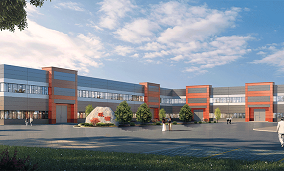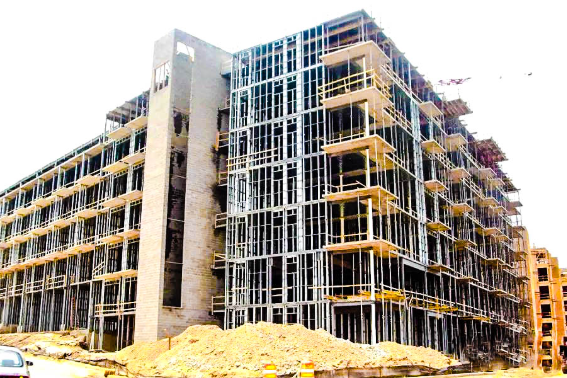Analysis and Discussion on the Design of Multi-Story Steel Structure Industrial Buildings
An overview of industrial building construction in China reveals that multi-story steel structure industrial buildings have emerged as a novel architectural type. Multi-story steel structures are widely favored by the public due to their unique advantages. Accordingly, designers must adopt corresponding strategies in their design to support the stability, reliability, and safety of multi-story steel structures, thereby laying a solid foundation for the overall usability and safety performance of the buildings.

I. Characteristics of Multi-Story Steel Structure Industrial Buildings
To enhance the design of multi-story steel structure industrial buildings and ensure they meet practical needs, it is essential to analyze their unique characteristics. Generally, light steel serves as the primary material in the structural system of multi-story steel structure industrial buildings. In other words, multi-story light steel structure industrial buildings possess the following characteristics: Firstly, they have a relatively low weight, which helps reduce the overall weight of the building. Secondly, they primarily utilize lightweight maintenance structures. Besides being lightweight, these structures offer numerous advantages, such as high load-bearing capacity and convenient installation. Lastly, the height of each floor is influenced by the intended use of the building. This not only does not affect the structural performance of the building but also effectively increases its interior space. Additionally, these buildings exhibit other characteristics, including short construction cycles, large live loads, and numerous suspended and concentrated loads.
II. Design Analysis of Multi-Story Steel Structure Industrial Buildings
Overall, the design of multi-story steel structure industrial buildings is based on their inherent characteristics. A scientific and reasonable design can not only improve construction efficiency, reduce environmental damage and pollution but also conserve energy. More importantly, it can meet the requirements of green building standards, achieve socio-economic benefits, and enable enterprises to embark on a sustainable development path. Therefore, this paper explores the overall design concept, key design points, and design approaches for multi-story steel structure industrial buildings.

1. Design Concept of Multi-Story Steel Structure Industrial Buildings
The design of multi-story steel industrial buildings differs from traditional steel structure design. It involves the simultaneous completion of structural and architectural design. This is primarily due to the advanced design software and special materials used in multi-story steel structure industrial buildings, enabling the integration of architectural and structural design processes. In contrast, traditional steel structures adhere to the design concept of "architecture first, structure later." The design concept of multi-story steel structure industrial buildings encompasses holistic design and cross-sectional optimization. Firstly, regarding holistic design:
Integrated design of maintenance systems and main structures: Currently, the predominant approach in China is to design these components separately. However, the optimal approach is to design them holistically.
Integrated architectural and structural design: This involves shifting away from the traditional "architecture first, structure later" approach to simultaneously completing architectural and structural design.
Secondly, regarding cross-sectional optimization design:
It is advisable to limit the number of angle steel specifications used in multi-story steel buildings to no more than five to facilitate material preparation. When specifications are similar, it is essential to unify their use to reduce the number of specifications.
For roof truss members connected with Grade C bolts and supporting rods, the side length of the angle steel should match the maximum diameter of the bolt.
In terms of cross-sectional thickness, it is preferable to select thinner sections while ensuring comparable stiffness with the same steel usage.
2. Key Design Points of Multi-Story Steel Structure Industrial Buildings
When designing multi-story steel structure industrial buildings, it is crucial to analyze various influencing factors based on practical conditions and optimize the settings and parameter calculation methods for multi-story steel structures. Specifically, the following design points should be considered: Firstly, it is essential to reasonably control the horizontal and vertical directions of the frame during the design process. For instance, to ensure the economic and structural stability of the building, the seismic resistance in both directions should be consistent. Additionally, to enhance the quality of the building, it is necessary to design appropriate expansion and seismic joints based on external environmental factors and appropriately increase the reinforcement ratio. Secondly, the design of the structural system plays a vital role in multi-story steel structure industrial buildings. Various structural systems are available, such as frame-shear wall and frame structures. When designing these buildings, it is crucial to select an appropriate structural system based on various influencing factors. For instance, when the number of floors is substantial, a frame-shear wall structural system should be adopted.
3. Design Approach for Multi-Story Steel Structure Industrial Buildings
When designing multi-story steel structure industrial buildings, it is essential to consider both the overall structure and key components. Therefore, a clear design approach is necessary. Numerous critical components exist in multi-story steel structure industrial buildings, such as joint configurations, support systems, and load-bearing capacities of multi-story steel structures. This paper analyzes the design approaches for some of these aspects. Firstly, regarding the design approach for support systems: Overall, continuous innovation and optimization are necessary in this area. Specifically, due to the relatively low lateral steel structure strength, it is essential to incorporate a horizontal support system into multi-story steel structure industrial buildings to prevent lateral steel structure displacement. Secondly, welding processes require attention. It is crucial to employ appropriate welding techniques to ensure that the quality of multi-story steel structure industrial buildings meets relevant regulations. For instance, the size of welding seams and weld spots must be thoroughly considered.



